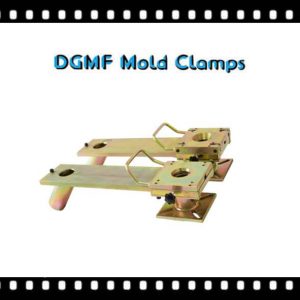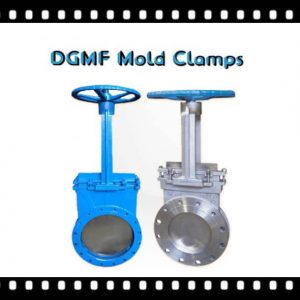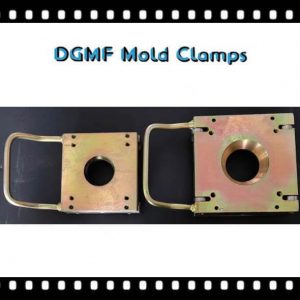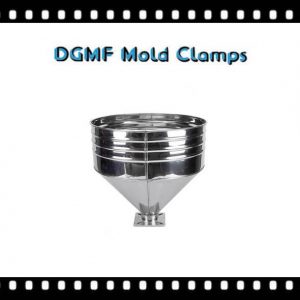Gate Valves
Gate Valves Slide Valve Supplier
DGMF Mold Clamps Co., Ltd is the gate valves slide valve supplier in China. We provide many different slide valve gate valve types for your best choice.
What is a gate valve?
A gate valve, also known as a sluice valve, is a valve that opens by lifting a barrier (gate) out of the path of the fluid. Gate valves require very little space along the pipe axis and hardly restrict the flow of fluid when the gate is fully opened.
A gate valve is a gate that opens and closes in the direction of movement perpendicular to the direction of the fluid and can only be fully opened and closed, not regulated or throttled.
The gate valve is sealed by contact between the valve seat and the gate plate, and the sealing surface is usually surfaced with metal materials to increase wear resistance, such as surfacing 1Cr13, STL6, stainless steel, etc.
The gate has a rigid gate and a resilient gate, according to the gate, the gate valve is divided into rigid gate and resilient gate valves.
What is the working principle of the gate valve?
The gate valve opening and closing member is the gate, the direction of movement of the gate is perpendicular to the direction of the fluid, the gate valve can only be fully open and fully closed, not for regulation and throttling.
Gate has two sealing surfaces, the most commonly used mode gate valve two sealing surfaces to form a wedge, wedge angle varies with the parameters of the valve, usually 5 °, and the medium temperature is not high when 2 ° 52 ‘.
Wedge gate valve gate can be made into a whole, called a rigid gate; can also be made into a gate that can produce a micro-deformation to improve its craftsmanship and compensate for the deviation of the sealing surface angle in the process, this gate is called a resilient gate.
What are the characteristics of gate valves?
Lightweight
The body is made of high-grade ductile iron, the weight is about 20%~30% lighter than traditional gate valves, easy to install and maintain.
Flat bottom gate seat
The traditional gate valve is often washed with water and then siltation of foreign objects such as stones, wood, cement, iron filings, debris, etc. in the groove of the valve bottom, easily causing failure to close tightly and the formation of leakage, the bottom of the resilient seat seal gate valve adopts the same flat bottom design as the water pipe machine, which is not easy to cause the siltation of debris and allows the fluid to flow freely.
Overall rubber cover
The gate uses high-quality rubber for internal and external encapsulation.
European rubber vulcanization technology enables the gate to be vulcanized to ensure accurate geometry, and the rubber is firmly bonded to the ductile cast gate, which is not easy to fall off and has good elastic memory.
Precision cast valve body
The precise geometry of the valve body allows the valve to be sealed without any finishing work.
What is the movement of the gate valve?
When the gate valve is closed, the sealing surface can only rely on the medium pressure to seal, that is, rely on the medium pressure to the sealing surface of the gate to the other side of the seat to ensure the sealing surface of the seal, which is self-sealing.
Most of the gate valves are forced to seal, that is, when the valve is closed, rely on external force to force the gate plate to the valve seat to ensure the sealing surface sealing.
Gate valve movement:
The gate valve with the gate plate along with the stem for linear movement, is called the lifting rod gate valve, also called the bright rod gate valve.
Usually, there are trapezoidal threads on the lift rod, and through the nut at the top of the valve and the guide groove on the valve body, the rotary motion is changed into a linear motion, which means that the operating torque is changed into an operating thrust.
When opening the valve, the passage of the fluid is completely open when the gate is lifted to a height equal to 1:1 times the valve’s passage diameter, but this position cannot be monitored during operation.
In actual use, it is marked by the apex of the valve stem, i.e. the position where it opens immovably, as its fully open position.
In order to take into account the locking phenomenon that occurs with temperature changes, the valve is usually opened to the apex position and then reversed by a 1/2-1 turn as the fully open valve position.
Therefore, the valve’s fully open position, according to the position of the gate plate is the stroke to determine. In some gate valves, the stem nut is located on the gate, and the handwheel rotation drives the stem rotation, while the gate plate lifts, this valve is called a rotary rod gate valve, or concealed rod gate valve.
What are the types of gate valves?
Gate valves are mainly divided into the following broad categories:
1. According to JB/T2203-1999 “gate valve structure length” production of the Ministry of Machinery standard valves;
2. The national standard valves produced according to GB/T12221-2005 “metal valve structure length”;
3. American standard valves produced according to ASME B16.10-2009 “Face-to-face and end-to-end dimensions of valves”.
How are gate valves classified?
Gate valves are divided into two categories: wedge type and parallel type according to the different structures of the gate.
There are 3 types of wedge-type gate structures: single gate, double gate, and resilient gate.
Gate valves are divided into flat gate valves and knife gate valves according to the type of structure.
What is the working principle of the manual gate valve?
The manual gate valve works by turning the handwheel and lifting or lowering the valve plate connected to the stem to open and close the valve through the in and out of the threads of the handwheel and stem.
According to the classification of shell/body materials, gate valves can be divided into
Metal material valves:
Such as carbon steel valves, alloy steel valves, stainless steel valves, cast iron valves, titanium alloy valves, Monel valves, copper alloy valves, lead alloy valves, etc.
Metal body lined valves:
Such as rubber-lined valves, fluorine-lined valves, lead-lined valves, plastic-lined valves, enamel lined valves.
Non-metallic material valves:
Such as ceramic valves, glass valves, PVC valves, and plastic valves.
What are the advantages and disadvantages of gate valves?
Advantages of the gate valve
1. Small flow resistance. The medium channel inside the valve body is straight through, the medium becomes straight flow, and the flow resistance is small.
2. Gate valves open and close with less effort. Is compared with the globe valve, because whether open or closed, the gate movement direction is perpendicular to the direction of media flow.
3. Gate valve height is large, and the opening and closing time is long. The opening and closing stroke of the gate is large, lifting is carried out through the screw.
4. Water hammer phenomenon is not easy to produce. The reason is that the closing time is long.
5. The medium can flow in any direction on both sides and is easy to install. Both sides of the gate valve channel are symmetrical.
6. The length of the gate valve structure (the distance between the two connecting ends of the housing) is small.
7. Gate valve shape is simple, short structure length, good manufacturing process, and has a wide range of applications.
8. Gate valve compact structure, valve rigidity, smooth passage, flow resistance number is small, sealing surface using stainless steel and hard alloy, long service life, using PTFE packing, reliable sealing, light, and flexible operation.
Disadvantages of the gate valve
1. General gate valve has two sealing surfaces, and processing, and manufacturing are more complex than the globe valve.
2. Gate valve sealing surface between the relative friction, wear, and tear, sealing surface wear repair is not convenient.
3. Valve cavity structure size, resulting in a long structure length, large size, installation space, and large diameter gate valve is particularly bulky.
4. Valve opening and closing times are long.
5. Gate valve can form a closed valve cavity, so when needed, should be set to prevent abnormal pressure relief structure in the cavity.
What are the main standards for gate valves?
(1) GB/T 12232-2005 General-purpose valves Flange-connected iron gate valves
(2) GB/T 12234-2019 Steel gate valve with stud connection bonnet for the oil and gas industry.
(3)GB/T 38008-2019 Thermoplastic gate valves.
(4) GB/T 32290-2015 resilient seal light gate valve for the water supply system.
(5) GB/T 28776-2012Steel gate, globe, and check valves for the oil and gas industry (≤ DN100).
(6) GB/T 24924-2010 resilient seal gate valves for water supply systems.
(7) GB/T 23300-2009 flat gate valve.
(8) GB8464-87 General Technical Regulations for Gate Valves, Globe Valves, Ball Valves, and Check Valves with Internal Thread Connection.
(9) GB8465.1-87 “female threaded connection gate valve, globe valve, ball valve, check valve basic size iron gate valve.
(10) JB/T53162-1999 “gate valve product quality classification.
(11) JB/T5298-91 “steel flat gate valve for a pipeline.
(12) JB/Z243-85 “gate valve static pressure life test procedures.
(13) JB/TQ648-8 “iron buttress type flat gate valve.
(14) JB/T53200-94 “iron counter-priced flat gate valve product quality classification.
(15) JB/T53242-94 “steel flat gate valve product quality classification.
Installation points of gate valve
1). Installation position, height, import and export direction must meet the design requirements, and the connection should be firm and tight.
2). All kinds of manual valves installed on the insulation pipeline, the handle shall not be down.
3). Valve installation must be checked before the appearance of the valve nameplate should be in line with the current national standard “General Valve Sign” GB 12220 provisions.
For working pressure greater than 1.0 MPa and in the main pipe to cut off the role of the valve, should be installed before the strength and tightness of the performance test, and qualified before use.
Strength test, test pressure for the nominal pressure of 1.5 times the duration of not less than 5min, the valve shell, packing should be no leakage for qualified.
Tightness test, test pressure for the nominal pressure of 1.1 times; test pressure in the test duration should be in line with the GB 50243 standard requirements, to the valve sealing surface no leakage as qualified.
4). Handwheel, handle, and transmission mechanism are not allowed to be used for lifting, collision is strictly prohibited.
5). Gate valve with transmission mechanism, according to the provisions of the product instructions for installation.
Precautions for the use of the gate valve
1. The handwheel, handle, and transmission mechanism of the gate valve are not allowed to be used for lifting, and collision is strictly prohibited.
2. Double gate valves should be installed vertically (i.e. the stem is in a vertical position and the handwheel is at the top).
3. Gate valve with a bypass valve should be opened before opening the bypass valve (to balance the pressure difference between the import and export and reduce the opening force).
4. Gate valves with transmission mechanisms should be installed according to the product instruction manual.
5. If the valve is frequently opened and closed, it should be lubricated at least once a month.
6. Gate valve is only fully open, fully close for all kinds of pipelines or equipment on the media running for, and not allowed for throttling use.
7. With a handwheel or handle gate valve, the operation shall not add an auxiliary bar (if the seal is not tight, then the sealing surface or other parts should be checked and repaired).
8. Gate valve handwheel, handle clockwise rotation for closed, and vice versa is open.
9. Gate valves with transmission mechanisms should be used according to the provisions of the product instruction manual.
DGMF Mold Clamps Co., Ltd manufactures the mold clamps and supplies the injection mold components, such as Clamps, Toggle Clamps, C Clamps, Pins, Bushings, Positioning Components, Lock Mold Components, Reset Extrusion, Cavity, and Core Components, Coolings, Die Press Components, Punch And Die, Guide Components, Self-lubricating Components, Springs, Machine Tools, Machine Mounts, Vises, Fasteners, Lifting, Bolts, Nuts, Washers, etc.
Contact the DGMF Mold Clamps teams for more details about the gate valves such as gate valves types and gate valves specifications, gate valves pricing, gate valves inventory, etc.
Showing all 7 results







